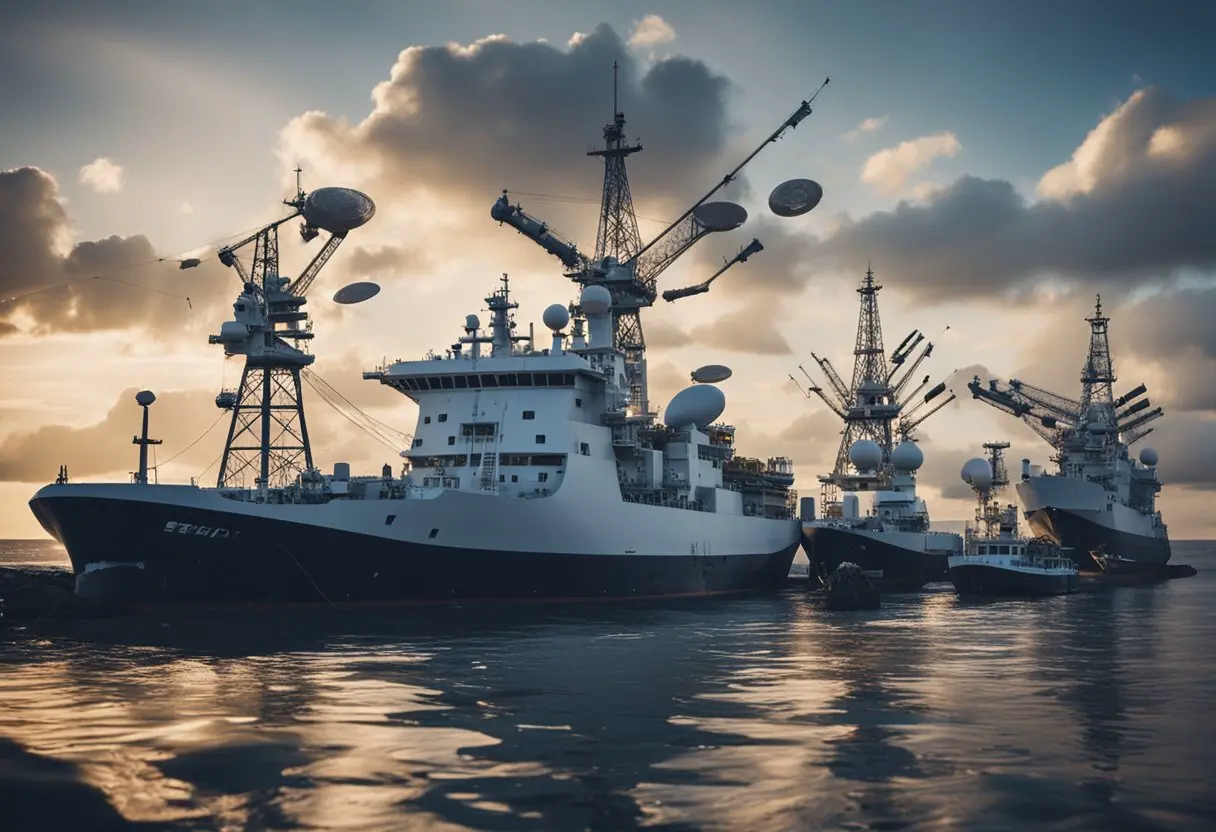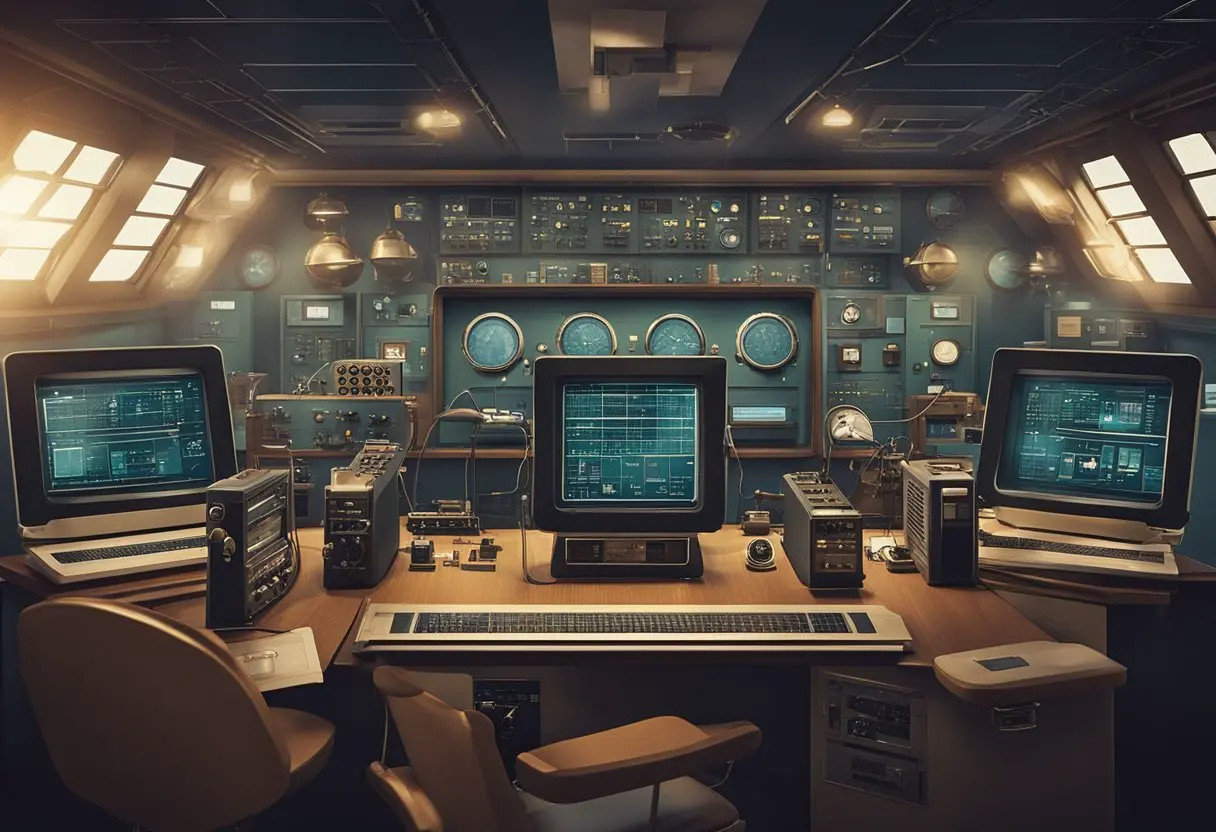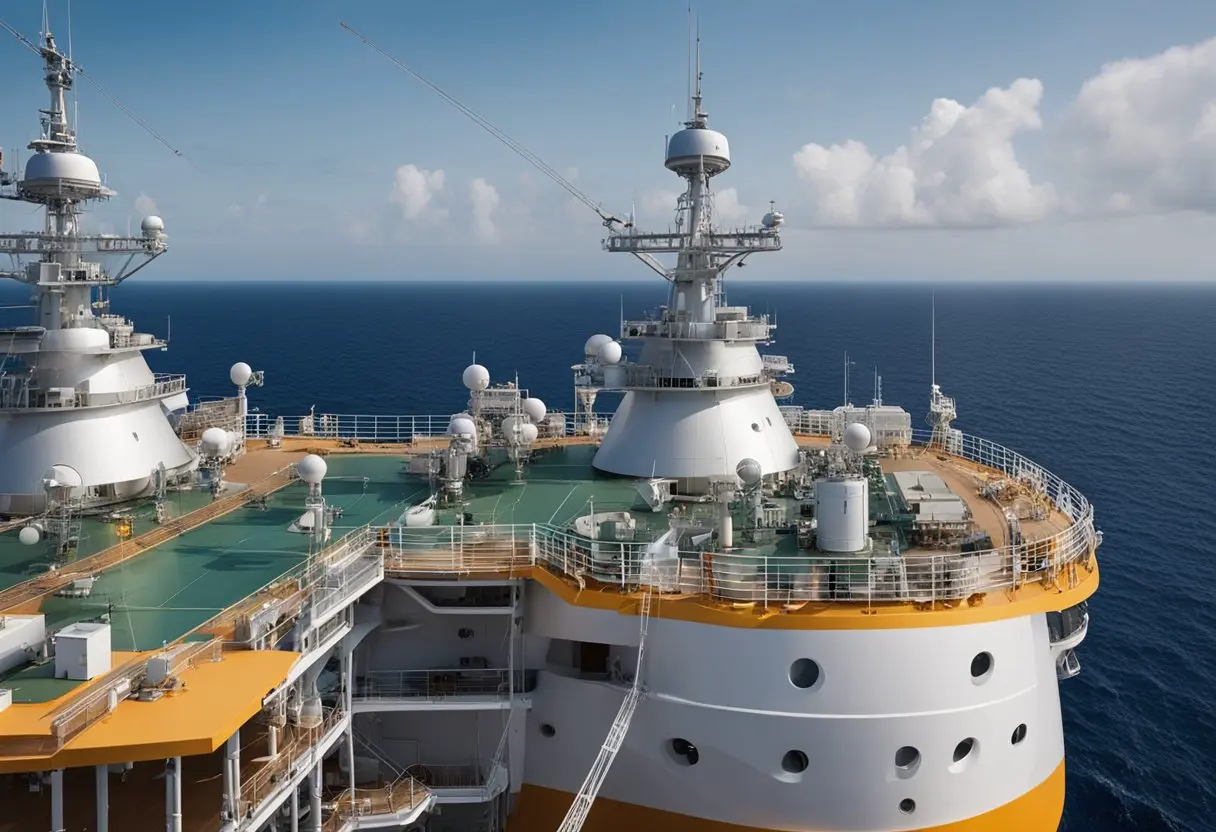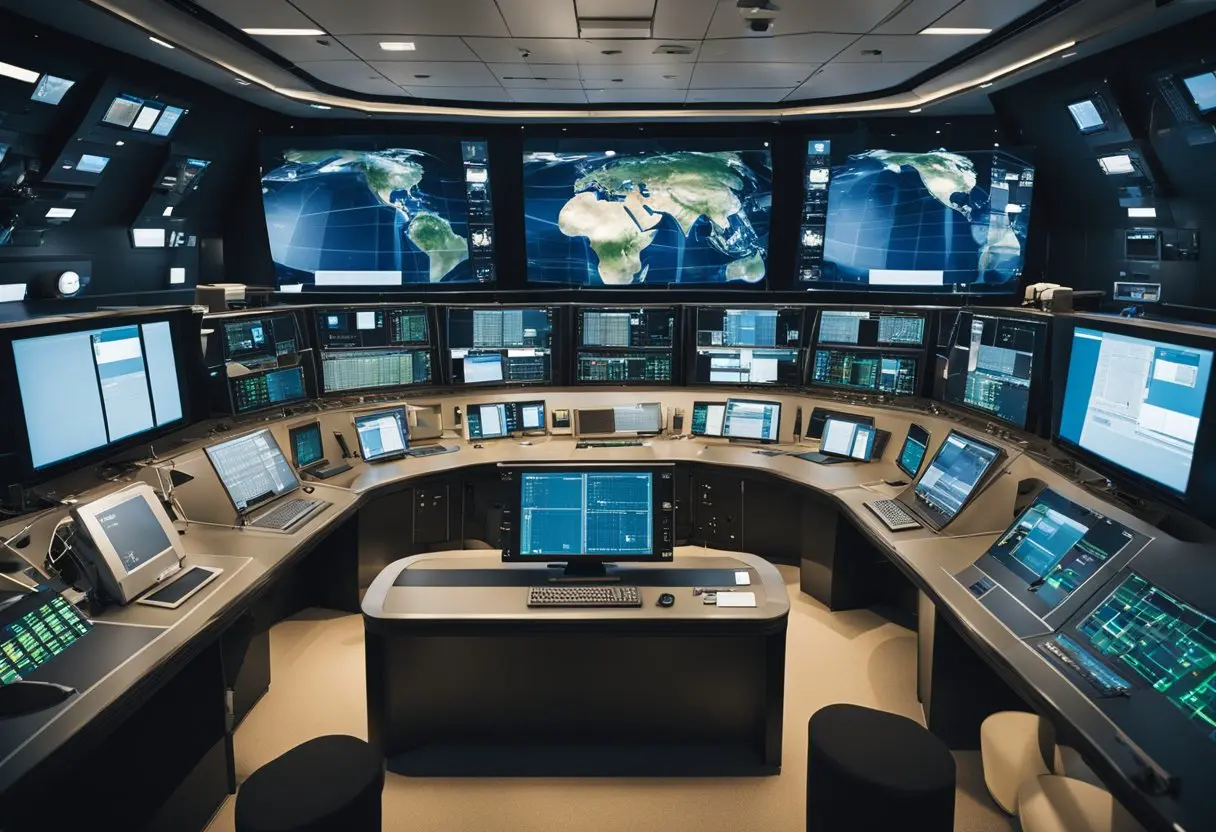How Internet and Communications Evolved on Ships: The maritime industry has come a long way since the days of relying on visual signaling methods and simple radio communication for ship-to-ship and ship-to-shore communication. The advent of the internet and modern communication technology has revolutionized the way ships communicate, making it safer, more efficient, and more convenient.
With the internet, ships can now communicate with the rest of the world in real-time, enabling faster decision-making and more efficient operations. Crew members can stay connected with their loved ones back home, access entertainment, and even receive training and education while at sea. The internet has also made it easier for ships to comply with regulations, such as those related to safety and environmental protection, by facilitating the exchange of information with regulatory bodies and other stakeholders.
Over the years, communication technology on ships has evolved from simple radio communication to satellite-based systems, such as very small aperture terminals (VSATs), which can handle large quantities of data. This has enabled ships to access a wide range of communication services, such as voice calling, video conferencing, email, and internet browsing, from anywhere in the world. As technology continues to advance, communication on ships will likely become even more seamless and integrated with other shipboard systems.
Early Communication on Ships

Communication at sea initially relied on simple visual signaling methods. Ancient civilizations employed the use of flags, torches, and smoke signals to convey messages between ships or between ships and shore. These methods were limited in their effectiveness, however, as they could only be used during daylight hours or clear weather conditions.
Visual Signaling Methods
Visual signaling methods were the earliest form of communication on cargo ships. They included the use of flags, torches, and smoke signals to convey messages. Flags were used to communicate between ships, with each flag representing a different letter or number. Ships would hoist flags in a certain order to spell out a message. Torches and lanterns were used at night, with different patterns of light representing different letters or numbers. Smoke signals were also used, with the color and pattern of smoke indicating different messages.
Semaphore and Flag Systems
Semaphore and flag systems were developed in the 18th and 19th centuries to improve communication on ships. Semaphore systems used a series of flags or arms that could be moved into different positions to represent letters and numbers. This allowed for faster and more accurate communication between ships. Flag systems were also developed during this time, with different flags representing letters and numbers. These systems were widely used by navies around the world and were an important precursor to modern communication technologies.
In summary, early communication on ships relied on visual signaling methods such as flags, torches, and smoke signals. Semaphore and flag systems were later developed to improve communication and were widely used by navies around the world. These early communication methods were limited in their effectiveness, but they laid the groundwork for the development of modern communication technologies.
Radio Communications Emergence on Ships

After the telegraph, wireless communication was the next big thing in the maritime industry. The first wireless telegraph system was invented by Guglielmo Marconi in 1895. His invention was initially used for land-based communication, but it was soon adapted for use on ships.
Wireless Telegraphy
Wireless telegraphy, also known as spark-gap telegraphy, was the first form of wireless communication used on ships. It allowed ships to communicate with each other and with shore stations using Morse code. The system used a spark gap transmitter that produced a series of radio waves that could be detected by a receiver on another ship or shore station.
Wireless telegraphy was a significant improvement over the traditional telegraph system because it allowed ships to communicate over long distances without the need for a physical wire. However, the system was not without its flaws. It was prone to interference from other radio signals, and the quality of the signal deteriorated over long distances.
Radio Telephone Systems
Radio telephone systems were the next evolution of wireless communication on ships. These systems allowed ships to communicate using voice instead of Morse code. The first successful radiotelephone transmission was made by Reginald Fessenden in 1900.
Radio telephone systems were a significant improvement over wireless telegraphy because they allowed for real-time communication between ships and shore stations. The system used amplitude modulation (AM) to encode the voice signal onto a radio wave. The receiver on the other end would then decode the signal and convert it back into sound.
In the early days of radiotelephone systems, the quality of the signal was poor, and the range was limited. However, as technology improved, the quality and range of the system improved, making it the primary form of communication on ships.
Overall, the emergence of radio communications revolutionized communication on ships, allowing for real-time communication over long distances. The wireless telegraphy system paved the way for the radio-telephone system, which allowed for voice communication.
Satellite Communication Revolution on Ships

Satellite communication has revolutionized ship-to-shore and ship-to-ship communication. Satellites provide global coverage, eliminating the limitations of terrestrial-based systems. This has enabled ships to stay connected to the internet and communicate with anyone in the world, regardless of their location.
INMARSAT Establishment
In 1979, the International Maritime Satellite Organization (INMARSAT) was established to provide satellite communication services to the maritime industry. INMARSAT offered voice and data communication services to ships at sea. It was a significant development as it allowed ships to communicate with their headquarters and other ships at sea, regardless of their location. INMARSAT’s services have since evolved to include broadband internet and other advanced communication services.
GPS Integration
The integration of the Global Positioning System (GPS) with satellite communication has further enhanced the capabilities of ships at sea. GPS allows ships to accurately determine their location and navigate to their destination. The integration of GPS with satellite communication has made it possible for ships to transmit their location data in real-time, which has improved safety and security at sea.
Satellite communication has played a significant role in the evolution of communication technology on ships. It has enabled ships to stay connected to the internet and communicate with anyone in the world, regardless of their location. The establishment of INMARSAT and the integration of GPS with satellite communication have further enhanced the capabilities of ships at sea.
Internet Advancements on Ships at Sea
As technology has advanced, so too can stay connected while at sea. With the advent of satellite communications, ships can have broadband internet access, which has revolutionized the way crews communicate and work while on board.
Broadband Internet Access
Satellite communications have allowed ships to have access to broadband internet while at sea. This has allowed crews to stay connected with family and friends back home, as well as to stay up to date with news and events happening around the world.
In addition, having broadband internet access has allowed for crews to work more efficiently while on board. With access to the internet, crews can communicate with other ships and with shore-based personnel more easily, which can help to improve safety and productivity.
Shipboard Wi-Fi Networks
With the availability of broadband internet access, many ships have also installed shipboard Wi-Fi networks. These networks allow crew members to use their devices, such as laptops and smartphones, to access the internet while on board.
Shipboard Wi-Fi networks have also allowed for crews to stay connected while on board. With the ability to use messaging apps and social media, crew members can communicate more easily and stay connected even when they are not in the same location on the ship.
Overall, the advancements in internet and communication technology on ships have transformed the way crews work and communicate while at sea. With broadband internet access and shipboard Wi-Fi networks, crews can stay connected with the outside world and with each other, which has improved safety, productivity, and crew welfare.
Modern Ship Communication Technologies

Integrated Bridge Systems
Modern ships are equipped with Integrated Bridge Systems (IBS) that incorporate the latest communication technologies. IBS integrates navigation, communication, and control systems into a single platform. It includes features such as an Electronic Chart Display and Information System (ECDIS), radar, Automatic Identification System (AIS), Global Positioning System (GPS), and Voyage Data Recorder (VDR). These systems enable ships to communicate with other vessels, port authorities, and the shore.
ECDIS is a digital chart system that displays real-time information about the ship’s position, speed, and course. It provides a clear view of the ship’s surroundings, including other vessels, navigational hazards, and weather conditions. AIS is a transponder system that broadcasts the ship’s identity, position, and other relevant information to other vessels and shore-based stations. GPS is a satellite-based navigation system that provides accurate positioning information. VDR records all communication and navigation data in case of an accident or incident.
Maritime Communication Services Providers
Maritime Communication Services Providers (CSPs) offer a range of communication services to ships, including voice, data, and internet services. CSPs use satellite technology to provide global coverage, ensuring that ships can communicate with the shore even in remote areas. They provide voice services through satellite phones, which are equipped with features such as call waiting, call forwarding, and voicemail. Data services include email, fax, and messaging. Internet services enable crew members to stay connected with their families and friends, access news and entertainment, and perform online tasks.
CSPs offer different pricing plans depending on the ship’s usage and the type of service. They also provide customer support and technical assistance to ensure that the communication systems are functioning properly. CSPs play a crucial role in ensuring that ships are connected to the shore and can communicate in case of emergencies.
In conclusion, modern ship communication technologies have revolutionized the maritime industry by providing safer and more efficient operations, enhancing connectivity, and improving crew welfare. Integrated Bridge Systems and Maritime Communication Services Providers are two key components of modern ship communication technologies that enable ships to communicate with the shore and other vessels.
Regulations and Safety on Modern Ships
The maritime industry is subject to various regulations and standards that govern communication equipment and procedures. These regulations and standards are put in place to ensure the safety of crew members, passengers, and vessels.
SOLAS Convention
The International Convention for the Safety of Life at Sea (SOLAS) is a treaty that sets minimum safety standards for ships. SOLAS requires that all ships carry communication equipment that meets specific requirements. This equipment includes VHF radio, MF/HF radio, and satellite communication equipment. SOLAS also requires that ships maintain a continuous watch on certain radio frequencies to monitor distress signals.
IMO Standards
The International Maritime Organization (IMO) is responsible for developing and maintaining standards for communication equipment and procedures. The IMO’s Global Maritime Distress and Safety System (GMDSS) is an internationally recognized set of safety procedures, frequencies, and equipment types that are used to facilitate communication between ships and shore. The GMDSS requires that ships carry specific communication equipment, including VHF radio, MF/HF radio, and satellite communication equipment.
The IMO also sets standards for the training of radio operators and for the testing and maintenance of communication equipment. These standards are designed to ensure that communication equipment is functioning properly and that operators can use the equipment effectively in emergencies.
In addition to SOLAS and IMO standards, there are also regional regulations that govern communication equipment and procedures. For example, the United States Federal Communications Commission (FCC) sets standards for communication equipment used in US waters.
Overall, these regulations and standards play an important role in ensuring the safety of ships and their crews. By requiring the use of specific communication equipment and procedures, these regulations help to ensure that ships can communicate effectively in emergencies.
Future Trends in Maritime Communication
As technology continues to advance, the future of maritime communication is likely to be shaped by several emerging trends. Two of the most important of these trends are autonomous ships and high-throughput satellites.
Autonomous Ships
Autonomous ships, which are ships that can operate without human intervention, are expected to become increasingly common in the coming years. These ships will rely on advanced communication networks to transmit data and receive instructions from shore-based operators.
One of the key benefits of autonomous ships is that they will be able to operate more efficiently than traditional ships. They will be able to optimize their routes and adjust their speed based on real-time data, which will help to reduce fuel consumption and lower operating costs.
High-Throughput Satellites
Another important trend in maritime communication is the development of high-throughput satellites. These satellites are designed to provide high-speed, low-latency internet connectivity to ships at sea.
With high-throughput satellites, ships will be able to access the internet and other communication services just as easily as they can on land. This will be especially important for crew members, who will be able to stay connected with their families and friends while at sea.
In addition, high-throughput satellites will also enable ships to transmit and receive large amounts of data quickly and reliably. This will be especially important for remote monitoring and control applications, which will require real-time data transmission and analysis.
Overall, the future of maritime communication is likely to be shaped by several emerging trends, including autonomous ships and high-throughput satellites. As these technologies continue to evolve, they will help to make shipping more efficient, safer, and more connected than ever before.
FAQs About Internet and Communications Evolved on Ships
What advancements have been made in maritime communication technology?
Maritime communication technology has advanced significantly over the years. From early visual signaling methods to modern satellite-based systems, the journey has been characterized by significant milestones and innovations. Today’s communication technology on ships includes advanced satellite communication systems, high-speed internet, and wireless communication devices. These advancements have enabled safer and more efficient operations, enhanced connectivity, and improved crew welfare.
What methods do ships currently use to access the internet?
Ships currently use a combination of satellite and cellular networks to access the internet. This connection is then used to provide a range of services, including voice and data communications, navigation, and operational support. The introduction of maritime internet has had a profound impact on the way ships operate, enabling them to stay connected with the rest of the world even when they are far away from shore.
Why is effective communication critical for modern maritime operations?
Effective communication is critical for modern maritime operations because it enables ships to stay connected with the rest of the world and with other ships in their vicinity. This connectivity is essential for ensuring the safety of crew members and passengers, as well as for ensuring that ships can operate efficiently and effectively. Without effective communication, ships would be unable to receive important information about weather conditions, navigational hazards, and other critical information that could impact their operations.
What are the challenges of providing stable internet connectivity at sea?
Providing stable internet connectivity at sea can be challenging due to several factors. For example, the movement of ships on the open water can cause signal interference, which can disrupt communication. Additionally, the distance between ships and shore-based communication stations can impact the strength and quality of the signal. Finally, weather conditions can also impact the stability of the signal, making it difficult to maintain a reliable connection.
How does satellite technology enable communication for ships on open water?
Satellite technology enables communication for ships on open water by providing a reliable connection that is not dependent on proximity to shore-based communication stations. Satellites orbiting the Earth can receive and transmit signals to ships, enabling them to stay connected even when they are far away from land. This technology has revolutionized the way ships operate, enabling them to stay connected with the rest of the world and with other ships in their vicinity.
You might also like
